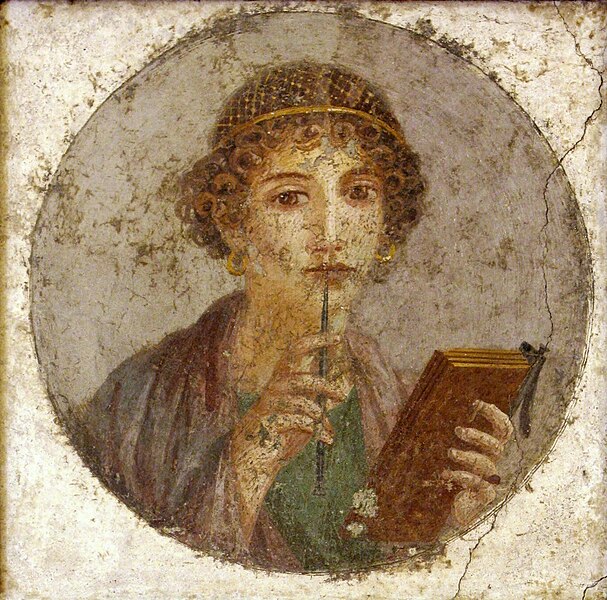 1
1title: Sappho fresco (from Pompeii)
artist:
Unknowndate: between 55 and 79
source: Yorck
description: Tondo of woman with wax tablets and stylus (so-called "Sappho"), National Archaeological Museum of Naples (inventory no. 9084). Roman fresco of about 50, from pompeii (VI, Insula Occidentalis) - Discovered in 1760, is one of the most famous and beloved paintings, commonly called Sappho. Actually portrays a high-society Pompeian woman, richly dressed with gold-threaded hair and large gold earrings, bringing the stylus to the mouth and holding the wax tablets, notoriously accounting documents which therefore have nothing to do with poetry and even less with the famous Greek writer.
license:Public domain
 2
2title: Sappho fresco (from Pompeii)
artist:
Unknowndate: between 55 and 79
source: Marisa Ranieri Panetta (ed.): Pompeji. Geschichte, Kunst und Leben in der versunkenen Stadt. Belser, Stuttgart 2005, ISBN|3-7630-2266-X , p. 181
description: Tondo of woman with wax tablets and stylus (so-called "Sappho"), National Archaeological Museum of Naples (inventory no. 9084). Roman fresco of about 50, from pompeii (VI, Insula Occidentalis) - Discovered in 1760, is one of the most famous and beloved paintings, commonly called Sappho. Actually portrays a high-society Pompeian woman, richly dressed with gold-threaded hair and large gold earrings, bringing the stylus to the mouth and holding the wax tablets, notoriously accounting documents which therefore have nothing to do with poetry and even less with the famous Greek writer.
license:Public domain
 3
3title: Sappho fresco (from Pompeii)
artist:
Unknowndate: between 55 and 79
source: link
description: Tondo of woman with wax tablets and stylus (so-called "Sappho"), National Archaeological Museum of Naples (inventory no. 9084). Roman fresco of about 50, from pompeii (VI, Insula Occidentalis) - Discovered in 1760, is one of the most famous and beloved paintings, commonly called Sappho. Actually portrays a high-society Pompeian woman, richly dressed with gold-threaded hair and large gold earrings, bringing the stylus to the mouth and holding the wax tablets, notoriously accounting documents which therefore have nothing to do with poetry and even less with the famous Greek writer.
license:Public domain
 4
4title: Sappho fresco (from Pompeii)
artist:
Unknowndate: between 55 and 79
source: sf
description: Tondo of woman with wax tablets and stylus (so-called "Sappho"), National Archaeological Museum of Naples (inventory no. 9084). Roman fresco of about 50, from pompeii (VI, Insula Occidentalis) - Discovered in 1760, is one of the most famous and beloved paintings, commonly called Sappho. Actually portrays a high-society Pompeian woman, richly dressed with gold-threaded hair and large gold earrings, bringing the stylus to the mouth and holding the wax tablets, notoriously accounting documents which therefore have nothing to do with poetry and even less with the famous Greek writer.
license:Public domain
 5
5title: Fresque des mytères, Pompéi
artist:
Unknown authordate: ca. 50 BCE
source: from ''Le Musée absolu'', Phaidon, 10-2012
credit: from Le Musée absolu, Phaidon, 10-2012
description: Silenus holding a lyre (left); demi-god Pan and a nymph sitting on a rock, nursing a goat (centre); woman with coat (right). fresco of the mystery ritual, right, Villa of the Mysteries, pompeii, Italy.
license:Public domain
 6
6title: A naked man and woman in sexual congress on a bed. Coloured Wellcome V0038951
artist: unknown
source: link * Gallery: link * Wellcome Collection gallery (2018-03-22): link [link CC-BY-4.0]
credit: link Gallery: link Wellcome Collection gallery (2018-03-22): link CC-BY-4.0
description:
A naked man and woman in sexual congress on a bed. Coloured process print.
Iconographic Collections - Erotic fresco in the Lupanar of pompeii.
license:
CC BY 4.0
 7
7title: Sappho fresco (from Pompeii)
artist:
Unknowndate: between 55 and 79
source: [link Flickr]
description: Tondo of woman with wax tablets and stylus (so-called "Sappho"), National Archaeological Museum of Naples (inventory no. 9084). Roman fresco of about 50, from pompeii (VI, Insula Occidentalis) - Discovered in 1760, is one of the most famous and beloved paintings, commonly called Sappho. Actually portrays a high-society Pompeian woman, richly dressed with gold-threaded hair and large gold earrings, bringing the stylus to the mouth and holding the wax tablets, notoriously accounting documents which therefore have nothing to do with poetry and even less with the famous Greek writer.
license:
CC BY-SA 2.0
 8
8title: Sappho fresco (from Pompeii)
artist:
Unknowndate: between 55 and 79
source: retouched||orig=fresco showing a woman so-called Sappho holding writing implements, from pompeii, Naples National Archaeological Museum (14842101892).jpg|editor=Martellkarl ger
description: Tondo of woman with wax tablets and stylus (so-called "Sappho"), National Archaeological Museum of Naples (inventory no. 9084). Roman fresco of about 50, from pompeii (VI, Insula Occidentalis) - Discovered in 1760, is one of the most famous and beloved paintings, commonly called Sappho. Actually portrays a high-society Pompeian woman, richly dressed with gold-threaded hair and large gold earrings, bringing the stylus to the mouth and holding the wax tablets, notoriously accounting documents which therefore have nothing to do with poetry and even less with the famous Greek writer.
license:
CC BY-SA 2.0




